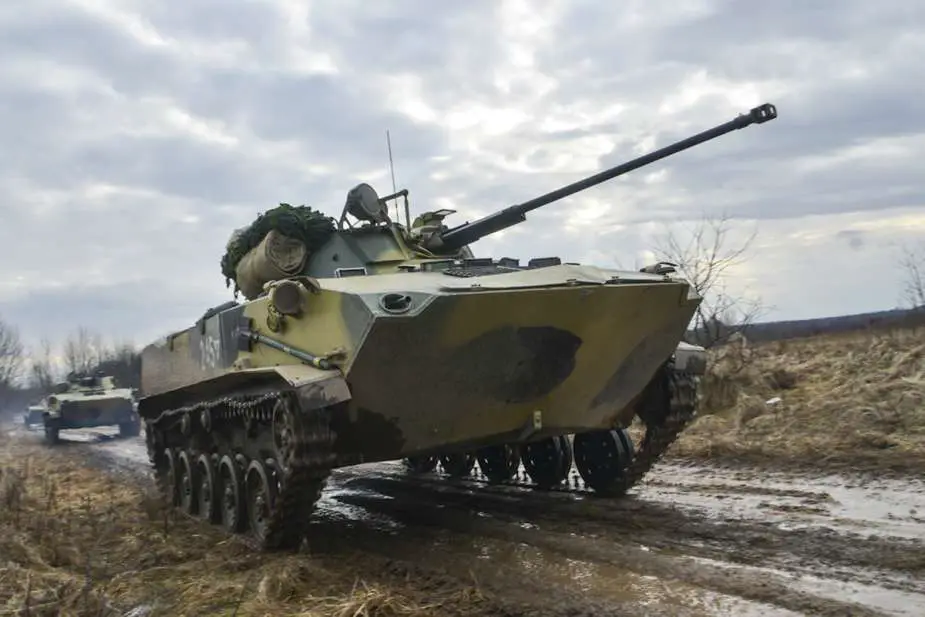New Delivery of BMD-2 and BTR-D Armored Vehicles for Russian Airborne Forces in Ukraine
Russia has delivered on time-renovated light armored vehicles, highlighting its ability to replace or repair damaged vehicles. The BMD-2 armored combat vehicles and BTR-D armored troop transports, after a complete overhaul, have been handed over to the Russian airborne forces, according to the Russian company Rostec.
Follow Army Recognition on Google News at this link

BMD-2 airborne tracked armored Infantry Fighting Vehicle. (Picture source: Russian MoD)
The 144th armored tank repair workshop, in collaboration with the Volgograd office of Kurganmashzavod, a company part of the "High Precision Systems" holding of the state corporation Rostec, delivered batches of these armored vehicles.
These vehicles, crucial for the operations of the paratrooper forces, underwent major repairs followed by rigorous testing to ensure their optimal performance. Accepted by representatives of the military commission, these renovated BMD-2 and BTR-D are ready to be deployed, reflecting the efforts to maintain the Russian armed forces' combat readiness at a high level.
The BMD-2 and the BTR-D are two armored vehicles designed by Russia and used by several countries, primarily for airborne operations and troop transport. Each of these vehicles has unique features suited to their specific missions.
The BMD-2 is a light airborne combat vehicle distinguished by its powerful armament and mobility. Equipped with a 30 mm cannon, two 7.62 mm PKT machine guns, and an anti-tank missile launcher capable of firing AT-4 or AT-5 missiles, the BMD-2 is designed to provide considerable fire support during airborne operations. Its welded aluminum alloy structure protects small arms while keeping the vehicle light enough to be air-transportable. Capable of carrying a crew of three plus four paratroopers, the BMD-2 can reach speeds of up to 60 km/h on the road and 10 km/h on water, with a range of 450 to 500 km, thanks to equipment such as a fire control system, night vision, and NBC protection.
On the other hand, the BTR-D is an airborne troop transport vehicle more focused on personnel transport than direct combat, although it is also armed for self-defense. With armament options including two 7.62 mm PKT machine guns, a 12.7 mm machine gun, or a 30 mm automatic grenade launcher, it offers defensive fire capability while transporting a crew of 14 (1 driver and 13 passengers). The BTR-D, also designed in Russia, incorporates protection against small arms fire and shell splinters, essential for deployment in combat zones. Weighing 8 tons, this vehicle reaches a maximum speed of 61 km/h and has an operational range of 500 km. Like the BMD-2, it is equipped with night vision systems and NBC protection, with a design emphasizing mobility and survival in hostile environments.
While the BMD-2 and BTR-D share some design aspects, such as their Russian origin and use by various countries, each vehicle fulfills distinct roles in the military context. The BMD-2 is optimized for combat with significant armament and mobility in various environments, while the BTR-D focuses on troop transport, offering superior transport capacity with protection adapted to battlefield threats. Together, these vehicles provide a versatile combination of strike force and rapid deployment capability, essential for modern combat and airborne transport operations.
Fizuli Seyfedov, executive director of the companies, expressed satisfaction with the timely completion of state defense orders, highlighting an increase in production, which more than tripled over the year. This expansion, accompanied by a modernization of production processes and an influx of new employees, reflects the positive dynamics within the Russian defense industry.
- Hits: 3163
















